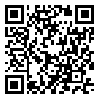BibTeX | RIS | EndNote | Medlars | ProCite | Reference Manager | RefWorks
Send citation to:
URL: http://salmandj.uswr.ac.ir/article-1-686-en.html
2- Department of Health, Deputy of Cultural and Social Affairs, Tehran Municipality, Tehran, Iran.
Objectives: This article aims to identifying social, cultural, economic, wellbeing, and urban structure needs of Tehran Seniors Association members and recognizing their current conditions in 8 areas with respect to WHO project on an age-friendly city indexes.
Methods & Materials: Four hundred members of Tehran Seniors Association who lived in Tehran were selected by random sampling method (276 women and 124 men with the mean age of 63 years) to participate in this descriptive-inferential study. Data were collected using a questionnaire, including inferential and descriptive parts. The descriptive part was divided into demographic characteristics with 12 questions and elders’ needs in 8 areas or 75 indexes. Scoring was conducted based on a 1 to 5 scale. Data analysis was performed using SPSS.
Results: In the area of open spaces and buildings, the highest score belonged to “cleanness of public areas” and the lowest score to “providing special services in stores and banks” (mean scores of 2.50 and 1.65, respectively. Regarding transportation area, the highest score went to “appropriate installment of traffic signs at cross-roads” and the lowest score to “seniors specific transportation” (mean scores of 3.03 and 1.58, respectively). Concerning housing, “suitability of interior design” got the highest score and “affordable and adequate housing” got the lowest one (mean scores of 1.93 and 1.51, respectively). Regarding social participation, “allowance of proper time to seniors special occasions” and “aiding elders at risk of social isolation” (mean scores of 2.88 and 2.07, resectively) got the maximum and minimum scores. Considering respect and socialization, “positive attitude toward elders in mass media” and “looking for elders’ advices on how to serve them better in commercial centers” (mean scores of 2.84 and1.74, respectively) gained the highest and lowest scores, respectively. Concerning citizenship participation and employment, the highest score belonged to “training senior employees for post-retirement jobs” and the lowest scores to “supporting self-employment opportunities for elders” (mean scores of 2.87 and 1.75, respectively). Regarding information and communication, “the feasibility of having oral communication” had the highest score and “free and open access of elders to computer and the Internet” (mean scores of 2.33 and 1.77, respectively) had the lowest score. finally, regarding social support and health services, “supporting and encourAgeing voluntary services” and “inclusion of both housekeeping services and health care in home care services” (mean scores of 2.23 and 1.78, respectively) scored as maximum and minimum.
Conclusion: Among the 8 areas, the mean elders’ assessment regarding the extent of their needs was less than the mean value (2.11). With some compromise, “social participation” was the only area that approached mean the value and “Housing” area has got the lowest score. In other words, elders’ need for housing was their main issue as compared to their other demands.
Received: 2015/05/01 | Accepted: 2015/08/14 | Published: 2015/10/01
| Rights and permissions | |
 |
This work is licensed under a Creative Commons Attribution-NonCommercial 4.0 International License. |





